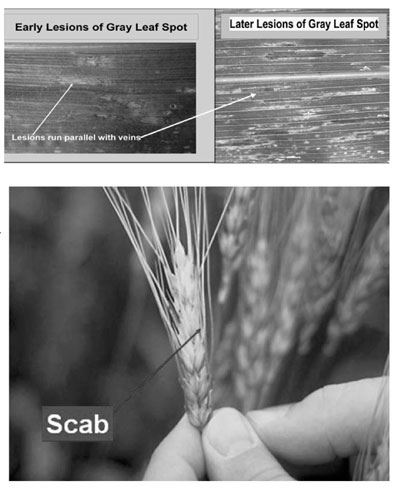Tips For Using Foliar Fungicides On Corn And Wheat
JACKSON, TENN.
Many corn and wheat producers are considering
spraying their crop with a fungicide
to control diseases. This interest has
been spurred by the increase in gray leaf spot
disease in corn and Fusarium head blight in
wheat. Tests at the Research and Education
Center at Milan, TN have shown a favorable increase
in disease control and yield when diseases
are present. Of course, not every field
should be sprayed. If there is no disease or very
little disease, the response will not be very great.
On the other hand, if the disease potential is
high, more increase can be expected compared
to the untreated. The more disease causing-factors
that are present, the more likely a fungicide
will increase yields.
Some important factors to consider when
spraying Corn:
1. Susceptibility or resistance of the corn Hybrids
to gray leaf spot (none are totally resistant
to all leaf diseases) is very important.
2. Continuous corn increases disease potential.
3. Tillage practices (no-till) that leave corn
residues on the surface of the ground will increase
disease potential. However, conventional
tillage may also promote foliar disease, especially
if fields are not rotated with other crops.
4. Later plantings tend to have more disease.
5. Irrigation will provide essential moisture for
diseases to develop.
6. Dry weather before and after tassel will reduce
foliar disease development.
7. Periods of rainy weather throughout the
growing season will increase the likelihood and
severity of disease.
8. Severe gray leaf spot will weaken the stalks
and may result in increased lodging.
Frequently Asked Questions about
spraying Corn
Which fungicides should producers use? The
strobilurin fungicides have given the best yield
increases in research plots. Headline, Quadris,
and Evito, have been tested and have given significant
disease control and higher yields. A
tank mix combination of a strobilurin fungicide
and a Triazole fungicide or a pre-mix (Quilt,
QuiltXcel, Stratego , Stratego YLD, Evito T or
Headline AMP) would be recommended especially
when Southern Corn Leaf Rust is expected
to be a problem but these combination fungicides
will also control other common diseases
such as Gray leaf Spot. Tilt, PropiMax and Domark
are Triazole fungicides that do not contain
a strobilurin but have
shown moderately good
control of certain diseases
as well. These should be
tank mixed with a strobilurin
fungicide for best
disease control.
When is the most effective
time to spray a fungicide?
For several years,
research has demonstrated
that corn should
be sprayed just at the
tasseling stage (VT). If
sprayed before tassel, the
fungicide may lose its effectiveness,
if sprayed too
late, when corn is in full
silk, disease control and
yield tend to drop off. If
silks have turned brown
or black, very little increase
in yield may result.

How should the fungicide
be applied? Most corn
is too tall at tassel to be
sprayed with a high cycle
sprayer, so many will use
aerial application. However,
some ground
sprayers are big enough
and may cause very little
damage.
How much water should
be applied? For best disease
control aerial applicators
should use at least
5 gallons of water per acre
with a fungicide adjuvant
or COC. Ground applicators should use 15-20
gallons of water per acre with a fungicide adjuvant
or COC. Nozzles that give smaller droplets
in the range of 300 microns will give better coverage.
Some Important factors to consider when
spraying Wheat:
1. Stage of growth. Wheat can be sprayed at
the Feekes’ Scale 10.3 (1/2 of head emerged) to
10.5 (head emergence is complete) when considering
control of Glume Blotch (caused by
Stagonospora spp.) and Rust diseases. But,
when the threat of Fusarium Head Blight is
strong, then spraying a Triazole containing fungicide
at the F 10.5.1(mid-bloom) would be recommended.
2. Fusarium Head Blight (FHB) or Head Scab is
caused by Fusarium spp. and causes spikelets
and heads to be killed and may produce high
levels of mycotoxins such as deoxyrivalenol
(DON) in some years. High levels of DON may
cause grain to be unsaleable. Fungicides containing
a Strobilurin type fungicide may increase
DON levels while at the same time increase overall
yields by controlling other foliar diseases.
Fungicides in the Triazole group do not increase
the DON levels and should provide a measure of
control of FHB. Some fungicides that contain
only Triazoles are: Prosaro, Caramba, Absolute,
Tilt. There are many premix fungicides that contain
both a Triazole and a Strobilurin fungicide.
3. DON levels may increase when wheat is in
the blooming stage (F10.5.1) especially when
there is continuous cloudy, damp or rainy
weather for several days. Dry weather during the
heading and flowering stages may limit the infection
process of Fusarium thereby reducing
FHB.
4. Crop rotation with at least a one year break
from a host crop such as corn, wheat, barley or
other cereals will help reduce Head Scab and
some other diseases as well.
5. Good spray cover is necessary for the best
control of foliar wheat disease. Usually, 5 gallons
of water per acre by airplane or 15 to 20 gallons
per acre by ground application provides the best
control. Adjuvants may increase the effectiveness
of fungicides but are not always necessary.
6. High rates of nitrogen fertilizer may increase
some diseases.
7. Wheat varieties differ in their susceptibility
to various diseases. Choose varieties with good
resistance or tolerance to Stripe and Leaf rust
disease as well as FHB. Δ
DR. MELVIN NEWMAN: Professor, University of
Tennessee